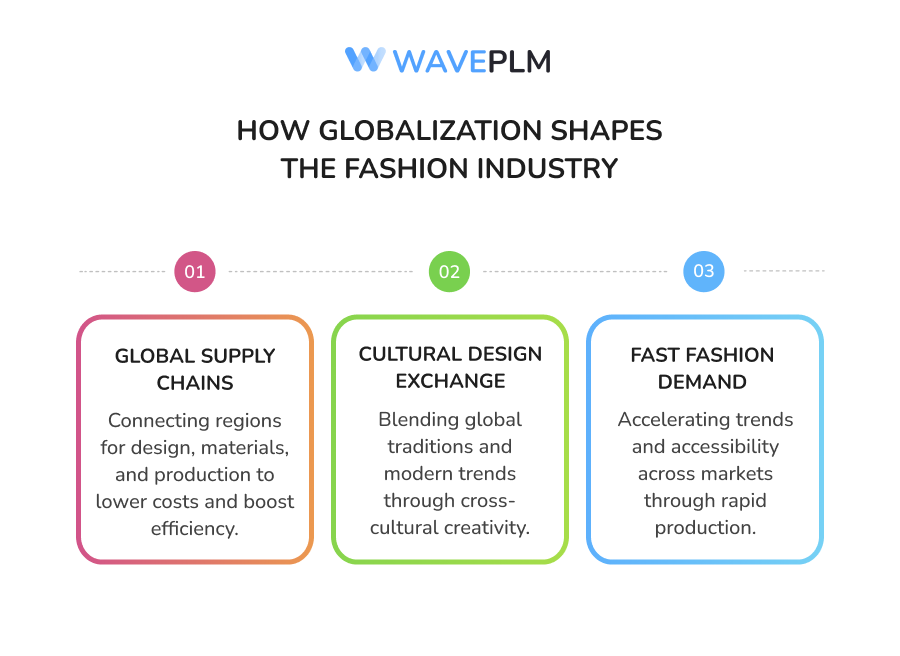
Fashion today crosses borders and cultures. Globalisation fashion has made style a universal language, connecting designers and consumers across the globe. From New York runways to small workshops in Asia, the fashion industry now operates on a global scale. This transformation allows brands to reach a global audience but demands technology for efficiency, ethical practices, and sustainability.
Fashion brands design in one country, source fabrics from another, and sell to customers worldwide. This global fashion network reflects how interconnected the clothing industry has become. Technology, especially Product Lifecycle Management (PLM) systems, plays a crucial role in uniting these processes into a seamless and transparent operation.
What Is Globalisation in Fashion?
Globalisation in fashion refers to the integration of design, production, and distribution across different countries. It links fashion companies, suppliers, and consumers on a single digital thread. A sketch in Paris becomes a prototype in Vietnam and a final product in New York – and all within weeks. This efficiency defines the globalized fashion model that dominates today.
|
Aspect |
Before Globalization |
After Globalization |
|---|---|---|
|
Production |
Local, small-scale, and domestic production |
Global and multi-country supply chains |
|
Cultural Influences |
Regional traditions |
Blended global cultures |
|
Time to Market |
Seasonal and slow |
Continuous and fast fashion cycles |
|
Technology |
Manual processes |
Artificial intelligence and automation |
The fashion industry began its globalisation journey in the late 20th century, seeking cost efficiency and economic growth. The rise of globalisation in fashion has led to a shift from domestic production to international manufacturing, with garment exports becoming a major source of income and economic growth for many countries. Now, digital innovation and PLM software make the global fashion network smarter and more sustainable.
How Globalization Shapes the Fashion Industry
Globalisation drives evolution across the fashion supply chain, design, and consumer behavior. Brands leverage global networks to achieve competitive prices by reducing production costs and expanding their reach. Let’s explore the main factors.
a. Global Supply Chains
The global fashion supply chain connects multiple regions for design, raw materials, and garment production. This model enables fashion brands to lower production costs while scaling up. Yet, it also increases the need for supply chain transparency and ethical practices. Consumers demand visibility—knowing where and how their clothes are made. Ethical supply chains and fair trade practices can help ensure the financial stability of workers and local communities by providing sustainable income and supporting economic growth.
b. Cultural Influence and Design Exchange
The fashion industry thrives on cultural exchange. Globalization influences and reshapes cultural identities through fashion, leading to new forms of cross-cultural expression and design. Designers mix traditional motifs, African prints, and local craftsmanship with modern aesthetics, often drawing inspiration from traditional clothing as a vital element of cultural heritage that is being reshaped by globalization.
This blend fuels fashion trends and celebrates cultural diversity. Fashion also serves as a means for individuals and communities to express their cultural identity, reflecting unique heritage and traditions. It is important to respect and promote different cultures within the global fashion landscape, including collaborations with artisans from various backgrounds. But it also raises issues of cultural appropriation versus cultural appreciation, pushing brands toward greater respect for cultural heritage and identity.
c. Fast Fashion and Global Demand
Fast fashion has redefined the pace of the global fashion market. Brands like Zara and H&M deliver trendy clothing at record speed, catering to consumer preferences worldwide. While mass production and rapid production increase accessibility, they also heighten environmental concerns and poor working conditions in some garment factories. The expansion of global trade in fashion has amplified these trends, as the international flow of garments influences both economic development and environmental impacts across borders. Many fashion brands are now promoting sustainable fashion through sustainable practices and ethical fashion commitments.

Challenges of a Globalized Fashion Industry
Operating globally brings both opportunities and responsibilities. The global fashion supply chain faces several key challenges:
|
Challenge |
Impact |
|---|---|
|
Sustainability |
Long shipping routes raise the carbon footprint and waste levels. |
|
Compliance |
Varying fair trade and labor laws complicate oversight. |
|
Data Fragmentation |
Multiple vendors cause communication and quality issues. |
|
Speed vs Quality |
Fast fashion cycles risk lowering craftsmanship standards. |
|
Ethics |
Maintaining fair wages and ethical practices is vital. |
Fashion brands need technology to handle these complexities. PLM systems help align global operations and reinforce accountability.
To address these challenges, it is crucial for fashion brands to prioritize sustainability in their global operations.
Economic Growth and the Global Fashion Economy
Globalization has transformed the fashion industry into a powerhouse of economic development, driving growth in both established and emerging markets. The expansion of global supply chains has enabled fashion brands to produce trendy clothing at unprecedented speed and scale, fueling the rise of fast fashion and opening doors to new markets around the world. As a result, the fashion industry now supports tens of millions of jobs, from garment workers in garment factories to designers and marketers reaching a global audience.
However, this rapid economic growth has brought significant challenges. The demand for cost efficiency and rapid production has sometimes led to poor working conditions and environmental concerns, as garment production ramps up to meet ever-changing fashion trends. The global nature of the supply chain means that fashion brands must navigate complex issues of supply chain transparency, fair wages, and ethical practices to ensure that economic development does not come at the expense of people or the planet.
In response, many fashion brands are embracing sustainable fashion and ethical fashion practices. The use of recycled materials, organic cotton, and eco-friendly production methods is becoming more common, helping to reduce the carbon footprint of clothing production.
Brands like Louis Vuitton have launched initiatives to promote sustainable practices throughout their supply chains, while others, such as Patagonia, are known for prioritizing fair wages and safe working conditions for garment workers. These efforts are essential for promoting sustainable fashion and ensuring that the benefits of economic growth are shared fairly across the clothing industry.
Cultural influences also play a vital role in the global fashion economy. The blending of traditional motifs, such as African prints, with modern fashion has enriched mainstream fashion and fostered cultural exchange. Yet, this cultural appreciation must be balanced with respect for cultural heritage and the avoidance of cultural appropriation, ensuring that the cultural significance of traditional attire and motifs is honored.
Technological advancements, including artificial intelligence and virtual fashion shows, have further accelerated the pace of fashion production and expanded the reach of fashion brands to global audiences. E-commerce platforms and digital innovation allow brands to respond quickly to shifting consumer preferences, launch new styles in record time, and compete in new markets. However, this rapid production cycle also raises concerns about waste, pollution, and the long-term sustainability of the fashion industry.
Looking back to the Middle Ages, clothing production was a slow, labor-intensive process, with garments often taking months to complete. Today, thanks to global supply chains and advanced technology, new fashion trends can be designed, produced, and delivered to consumers in just weeks. While this efficiency has driven economic growth, it also underscores the need for the fashion industry to prioritize sustainable practices, fair trade, and ethical fashion.
As the global fashion economy continues to evolve, fashion brands must embrace innovation while committing to responsible growth. By prioritizing sustainability, ethical practices, and cultural appreciation, the fashion industry can reduce its environmental impact, promote fair wages and safe working conditions, and contribute to economic development in a way that benefits both people and the planet. The future of global fashion lies in balancing creativity and commerce with a deep respect for cultural diversity and a commitment to sustainable fashion practices.

How PLM Software Supports Globalized Fashion Operations
Product Lifecycle Management (PLM) software connects global teams, creating efficiency, visibility, and sustainability across the supply chain. It becomes the single source of truth for every department.
Wave PLM empowers fashion brands to achieve transparency, traceability, and innovation while prioritizing sustainability. By embracing innovation, PLM enables brands to build more resilient, sustainable, and efficient supply chains in a rapidly evolving market.
|
PLM Feature |
Global Fashion Benefit |
|---|---|
|
Centralized Data |
One shared database for design, materials, and suppliers |
|
Real-time Collaboration |
Seamless teamwork across continents and time zones |
|
Compliance Tracking |
Monitors fair trade, quality, and safety standards |
|
Supplier Management |
Improves relationships and measures ethical performance |
|
Cost Control |
Tracks production costs and delivery timelines efficiently |
With PLM, brands oversee the entire journey – from concept to consumer – while supporting ethical fashion and supply chain transparency.

Example Workflow with Wave PLM:
|
Stage |
PLM Role |
|---|---|
|
Design |
Centralized design libraries and virtual fashion shows |
|
Sourcing |
Partner selection and fair trade evaluation |
|
Production |
Supply chain visibility and real-time updates |
|
Compliance |
Automatic documentation for global standards |
|
Launch |
Market analysis and AI-based forecasting |
The Future: From Globalization to Glocalization
The future of global fashion lies in glocal fashion – balancing global reach with local customization. Using artificial intelligence, 3D modeling, and digital product twins, fashion brands can predict demand, reduce waste, and make sustainable fashion scalable.
|
Trend |
Tech Driver |
Impact on Fashion Industry |
|---|---|---|
|
On-demand Production |
AI & PLM Integration |
Reduces overproduction and waste |
|
Local Customization |
Digital Twins |
Creates personalized trendy clothing |
|
Sustainable Sourcing |
Smart Supplier Analytics |
Improves ethical and eco-friendly outcomes |
|
Virtual Fashion Shows |
AR/VR Tools |
Reaches global audience instantly |
International fashion weeks in cities like Paris, Milan, London, and New York, as well as in emerging markets such as Shanghai, Mumbai, and São Paulo, will continue to play a key role in shaping global fashion trends and promoting cross-cultural exchange.
This evolution encourages brands to embrace innovation, protect cultural diversity, and pursue sustainable practices while maintaining cost efficiency and creativity.
A Connected and Sustainable Future
Globalisation has reshaped the fashion industry into a global phenomenon that merges creativity, commerce, and responsibility. The fashion industry is deeply interconnected with the global economy, influencing employment opportunities, trade, and development across nations. Through PLM systems like Wave PLM, fashion brands can ensure transparency, sustainability, and fairness across every level of the supply chain.
The future of modern fashion depends on balancing innovation with responsibility. Global fashion thrives when technology drives ethical fashion, fair trade, and sustainable practices—ensuring that every piece of clothing tells a story of both culture and conscience.
Quick Summary Template for Readers:
|
Topic |
Key Insight |
|---|---|
|
Definition |
Integration of design, production, and sales worldwide |
|
Fast Fashion Impact |
Rapid cycles that demand accountability and transparency |
|
Supply Chain |
Global network linking design, production, and distribution |
|
PLM Role |
Enables supply chain transparency and collaboration |
|
Future Outlook |
From globalization to glocalization through PLM and AI |
In today’s globalized world, technology like PLM unites creativity, sustainability, and ethics. The global fashion industry continues to evolve, and with tools like Wave PLM, it can do so responsibly—celebrating both cultural heritage and innovation.





Leave a Reply